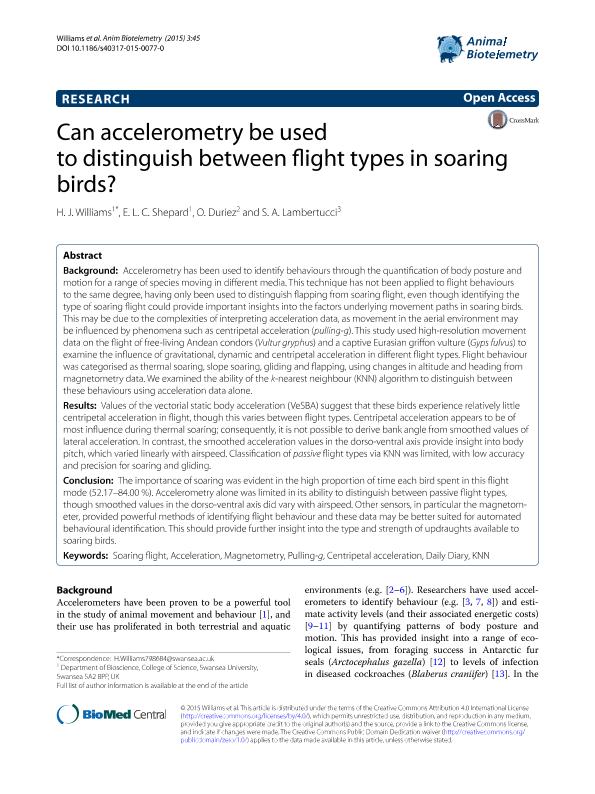Artículo
Can accelerometry be used to distinguish between flight types in soaring birds?
Fecha de publicación:
09/2015
Editorial:
BioMed Central
Revista:
Animal Biotelemetry
ISSN:
2050-3385
Idioma:
Inglés
Tipo de recurso:
Artículo publicado
Clasificación temática:
Resumen
Background: Accelerometry has been used to identify behaviours through the quantification of body posture and motion for a range of species moving in different media. This technique has not been applied to flight behaviours to the same degree, having only been used to distinguish flapping from soaring flight, even though identifying the type of soaring flight could provide important insights into the factors underlying movement paths in soaring birds. This may be due to the complexities of interpreting acceleration data, as movement in the aerial environment may be influenced by phenomena such as centripetal acceleration (pulling-g). This study used high-resolution movement data on the flight of free-living Andean condors (Vultur gryphus) and a captive Eurasian griffon vulture (Gyps fulvus) to examine the influence of gravitational, dynamic and centripetal acceleration in different flight types. Flight behaviour was categorised as thermal soaring, slope soaring, gliding and flapping, using changes in altitude and heading from magnetometry data. We examined the ability of the k-nearest neighbour (KNN) algorithm to distinguish between these behaviours using acceleration data alone.
Results: Values of the vectorial static body acceleration (VeSBA) suggest that these birds experience relatively little centripetal acceleration in flight, though this varies between flight types. Centripetal acceleration appears to be of most influence during thermal soaring; consequently, it is not possible to derive bank angle from smoothed values of lateral acceleration. In contrast, the smoothed acceleration values in the dorso-ventral axis provide insight into body pitch, which varied linearly with airspeed. Classification of passive flight types via KNN was limited, with low accuracy and precision for soaring and gliding.
Conclusion: The importance of soaring was evident in the high proportion of time each bird spent in this flight mode (52.17–84.00 %). Accelerometry alone was limited in its ability to distinguish between passive flight types, though smoothed values in the dorso-ventral axis did vary with airspeed. Other sensors, in particular the magnetometer, provided powerful methods of identifying flight behaviour and these data may be better suited for automated behavioural identification. This should provide further insight into the type and strength of updraughts available to soaring birds.
Palabras clave:
Soaring Flight
,
Acceleration
,
Daily Diary
,
Magnetometry
Archivos asociados
Licencia
Identificadores
Colecciones
Articulos(INIBIOMA)
Articulos de INST. DE INVEST.EN BIODIVERSIDAD Y MEDIOAMBIENTE
Articulos de INST. DE INVEST.EN BIODIVERSIDAD Y MEDIOAMBIENTE
Citación
Williams, H. J.; Shepard, E. L. C.; Duriez, O.; Lambertucci, Sergio Agustin; Can accelerometry be used to distinguish between flight types in soaring birds?; BioMed Central; Animal Biotelemetry; 3; 45; 9-2015; 1-11
Compartir
Altmétricas




